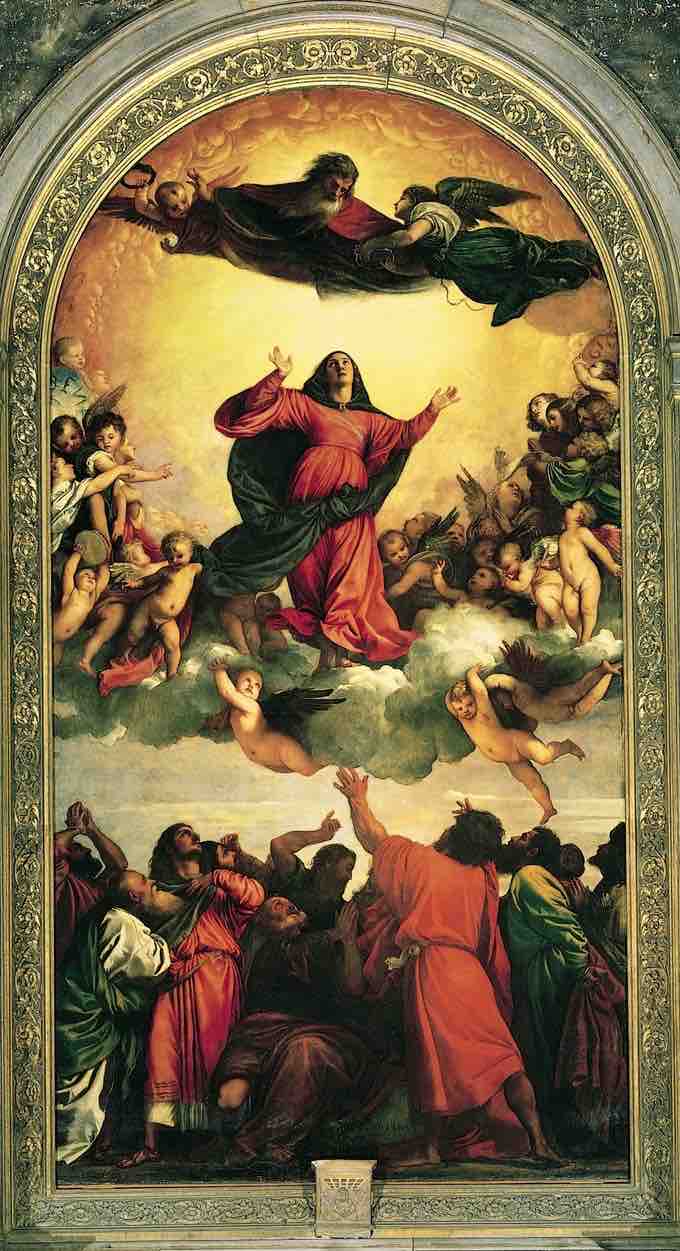Venetian painting during the High Renaissance
Giorgione, Titian, and Veronese were the preeminent painters of the Venetian High Renaissance. All three similarly employed novel techniques of color and composition, which established them as acclaimed artists north of Rome. In particular, Giorgione, Titian, and Veronese follows the Venetian School's preference of color over disegno.
Giorgione
Giorgio Barbarelli da Castlefranco, known as Giorgione (c. 1477–1510), is an artist who had considerable impact on the Venetian High Renaissance. Unfortunately, art historians do not know much about Giorgione, partly because of his early death at around age 30, and partly because artists in Venice were not as individualistic as artists in Florence. While only six paintings are accredited to him, they demonstrate his importance in the history of art as well as his innovations in painting.
Giorgione was the first to paint with oil on canvas. Previously, people who used oils were painting on panel, not canvas. His works do not contain much under-drawing, demonstrating how he did not adhere to Florentine disegno, and his subject matters remain elusive and mysterious. One of his works that demonstrates all three of these elements is The Tempest (c. 1505–1510). This work is oil on canvas, x-rays show there is very little under drawing, and the subject matter remains one of the most debated issues in art history.
The Tempest, c, 1505–1510, Giorgione.
This work by Giorgione encapsulates all of the innovations he brought to painting during the Venetian High Renaissance and remains one of the most debated paintings of all time for its elusive subject matter.
Titian
Tiziano Vecelli, or Titian (1490–1576), was arguably the most important member of the 16th century Venetian school, as well as one of the most versatile; he was equally adept with portraits, landscape backgrounds, and mythological and religious subjects. His painting methods, particularly in the application and use of color, would have a profound influence not only on painters of the Italian Renaissance, but on future generations of Western art. Over the course of his long life Titian's artistic manner changed drastically, but he retained a lifelong interest in color. Although his mature works may not contain the vivid, luminous tints of his early pieces, their loose brushwork and subtlety of polychromatic modulations were without precedent
In 1516, Titian completed his well-known masterpiece, the Assumption of the Virgin, or the Assunta, for the high altar of the church of the Frari. This extraordinary piece of colorism, executed on a grand scale rarely before seen in Italy, created a sensation. The pictorial structure of the Assumption—uniting in the same composition two or three scenes superimposed on different levels, earth and heaven, the temporal and the infinite—was continued in a series of his works, finally reaching a classic formula in the Pesaro Madonna (better known as the Madonna di Ca' Pesaro). This perhaps is Titian's most studied work; his patiently developed plan is set forth with supreme display of order and freedom, originality and style. Here, Titian gave a new conception of the traditional groups of donors and holy persons moving in aerial space, the plans and different degrees set in an architectural framework.

Assunta, Titian
It took Titian two years (1516–1518) to complete his Assunta. The painting's dynamic three-tier composition and color scheme established him as the preeminent painter north of Rome.
Veronese
Paolo Veronese (1528–1588) was one of the primary Renaissance painters in Venice, well known for paintings such as The Wedding at Cana and The Feast in the House of Levi. Veronese is known as a supreme colorist, and for his illusionistic decorations in both fresco and oil. His most famous works are elaborate narrative cycles, executed in the dramatic and colorful style, full of majestic architectural settings and glittering pageantry.
His large paintings of biblical feasts executed for the refectories of monasteries in Venice and Verona are especially notable. For example, in The Wedding at Cana, which was painted in 1562–1563 in collaboration with Palladio, Veronese arranged the architecture to run mostly parallel to the picture plane, accentuating the processional character of the composition. The artist's decorative genius was to recognize that dramatic perspective effects would have been tiresome in a living room or chapel, and that the narrative of the picture could best be absorbed as a colorful diversion.
The Wedding at Cana offers little in the representation of emotion: rather, it illustrates the carefully composed movement of its subjects along a primarily horizontal axis. Most of all, it is about the incandescence of light and color. Even as Veronese's use of color attained greater intensity and luminosity, his attention to narrative, human sentiment, and a more subtle and meaningful physical interplay between his figures became evident.
The Wedding at Cana, Paolo Veronese (1562–1563)
The artist's decorative genius in The Wedding at Cana was to recognize that dramatic perspective effects would have been tiresome in a living room or chapel, and that the narrative of the picture could best be absorbed as a colorful diversion.